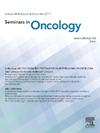干扰素-γ在急性髓系白血病中的双重作用:综述
IF 2.5
3区 医学
Q2 ONCOLOGY
引用次数: 0
摘要
急性髓性白血病(AML)是一种血液系统恶性肿瘤,表现为骨髓前体在骨髓和外周循环中非常迅速、不受控制的生长。AML的研究强调了IFN-γ治疗在免疫监视中的关键作用,对白血病细胞的促进和抑制作用,以及肿瘤微环境的调节。然而,有必要全面了解IFN-γ在AML中的双重作用。因此,本综述旨在评估IFN-γ在AML中的双重作用。文献检索在Pub Med、b谷歌Scholar和直接谷歌Search中进行。数据以表格和图表的形式呈现,并通过叙述综合的方式总结了调查结果。根据情况和疾病的分期,IFN-γ在AML患者中表现出两种不同的活性。首先,IFN-γ增强NK细胞和CD8+ T淋巴细胞功能,共同唤起抗白血病免疫。IFN-γ的另一个有希望的作用包括骨髓细胞的分化,从而可能降低白血病的严重程度。然而,长期暴露于IFN-γ可以激活Treg细胞和抑制免疫检查点,这可以帮助白血病逃避免疫监视并遇到免疫抑制环境。我们的综述强调了IFN-γ在免疫系统和AML发病机制之间复杂的相互作用中的关键作用。它在抑制和促进白血病过程中的双重作用已被强调。然而,未来的临床前和临床研究应关注IFN-γ影响AML进展和治疗结果的具体机制,以实现患者的治愈效果。本文章由计算机程序翻译,如有差异,请以英文原文为准。
The dual effect of interferon-γ in acute myeloid leukemia: A narrative review
Acute myeloid leukemia (AML) is a hematological malignancy representing a very rapid, uncontrolled growth of myeloid precursors in the BM and peripheral circulation. Studies on AML have highlighted the crucial role of IFN-γ therapy in immune surveillance, both promotive and inhibitory effects on leukemic cells, and regulation of the tumor microenvironment. However, there is a need for a comprehensive understanding of the dual effects of IFN-γ in AML. Thus, this review aimed to assess the dual effects of IFN-γ in AML. Literature searches were conducted in Pub Med, Google Scholar, and direct Google Search. The data was presented in tables and figures, with findings summarized through a narrative synthesis. Depending on the circumstances and stage of the disease IFN-γ shows two different activities in AML patients. First, IFN-γ enhances NK cells and CD8+ T lymphocyte functions, which collectively evoke antileukemic immunity. Another promising effect of IFN-γ includes the differentiation of myeloid cells, thereby possibly reducing the severity of leukemia. However, prolonged exposure to IFN-γ can activate Treg cells and inhibitory immunological checkpoints, which can help leukemia evade immune surveillance and encounter an immunosuppressive environment. Our review highlights IFN-γ's critical role in the complex interplay between the immune system and AML pathogenesis. Its dual role in both inhibiting and promoting leukemic processes has been highlighted. However, future pre-clinical and clinical studies should focus on the specific mechanisms by which IFN-γ impacts AML progression and treatment outcomes, with the goal of achieving curative results for patients.
求助全文
通过发布文献求助,成功后即可免费获取论文全文。
去求助
来源期刊

Seminars in oncology
医学-肿瘤学
CiteScore
6.60
自引率
0.00%
发文量
58
审稿时长
104 days
期刊介绍:
Seminars in Oncology brings you current, authoritative, and practical reviews of developments in the etiology, diagnosis and management of cancer. Each issue examines topics of clinical importance, with an emphasis on providing both the basic knowledge needed to better understand a topic as well as evidence-based opinions from leaders in the field. Seminars in Oncology also seeks to be a venue for sharing a diversity of opinions including those that might be considered "outside the box". We welcome a healthy and respectful exchange of opinions and urge you to approach us with your insights as well as suggestions of topics that you deem worthy of coverage. By helping the reader understand the basic biology and the therapy of cancer as they learn the nuances from experts, all in a journal that encourages the exchange of ideas we aim to help move the treatment of cancer forward.
 求助内容:
求助内容: 应助结果提醒方式:
应助结果提醒方式:


